Fall Bird
Banding
Ongoing research suggests that many songbirds breeding on the west slope of the Sierra Nevada also rely higher elevation molting grounds, prior to migration. After fledging young in May and June, both adults and Hatch-Year birds disperse to higher elevations and concentrate in meadows dominated by willows. Data from Yuba Pass suggest that adults may remain at a favorable site for upwards of 70 days, and data from Yuba Pass and Devils Postpile demonstrate strong post-breeding site fidelity between years (J. Steele, unpub. data, Richardson and Moss 2010). Mist-netting birds at these sites can help shed light usage patterns, allow researchers to collect valuable data on molt and mass gain during these periods, and determine the relative value of sites as molting grounds and stopover sites for post-breeding and migrant passerines.
Besides the clear scientific value of mist-netting at these sites, bird banding can be extremely effective as an educational and community outreach tool, showing birds and explaining ornithological research up close to participants (Pitkin 2005). By inviting organized groups and the general public to experience banding demonstrations, we can more effectively educate them about our research, conservation, and restoration efforts, inspire a greater appreciation of Tahoe’s natural history and birds in general, and clearly demonstrate the link between science and conservation.
In 2010, TINS, in collaboration with the California Tahoe Conservancy, began a long-term monitoring program of weekly mist-netting at the Cove East restoration area during August and September of each year. In 2011, we added a site in Blackwood Canyon and extended mist-netting efforts into October, and in 2012, we added an additional site: Pope's Marsh. In recent years, staffing demands have prevented us from banding at Cove East and Pope’s Marsh consistently, but we hope to fix that soon!
For information on banding demonstrations, please contact Sarah Hockensmith. For other inquiries about our bird banding project, please contact Will Richardson.
REFERENCES:
Pitkin, M. 2005. Mist-netting with the public: A guide for communicating science to the public. MS Thesis, Southern Oregon University, Ashland, OR.
Richardson, T. W., and S. S. Moss. 2010. Bird Monitoring at Devils Postpile National Monument: Results from the 2009 Field Season. Final report presented to the National Park Service. PRBO Contribution # 1729.
Banding a Spotted Towhee for students
Banding during migration can get busy - each of these bags contains a bird!


